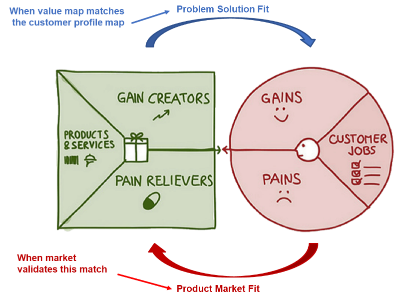In the last part of this series on product growth engine for innovation and business growth, we discuss three questions one should ask during the product development phase.
During new product development, business planning and strategic thinking, product managers, innovators and entrepreneurs should ask three important questions. These three questions form the basis for a product growth engine that can help businesses get over the product adoption curve and achieve consistent and sustainable growth.
These questions need to be asked as a product goes through the life cycle:
Three Important Questions

Is There a Gap in the Market?
To answer Question 1, “Is there a gap in the market?”, you will need to ensure that a Problem-Solution Fit is established prior to building and introducing the product in the market. The best way to do it is to identify an existing problem (gap) in the target market and to solve it with a solution that customers find satisfaction. A gap in the market is a market opportunity to create and sell a product that is not available yet. Once you’ve identified the gap and pain points, you can then build the business case and work towards the solution.
One systematic way to find a product-solution fit is to make use of the Value Proposition Canvas that was designed by Dr Alexander Osterwalder, creator of the Business Model Canvas.
Value Proposition Canvas

(Image source: “Great Value Proposition Examples” by Robin Nichols)
The goal of the Value Proposition Canvas is to help you identify your customer’s needs and jobs-to-be-done and create the product that solve their problems.
A problem-solution fit is achieved when the solution has been validated with the customers. This needs to be done in order to avoid building something customers don’t want.
Once the product-solution fit is reached, you would know with almost certainty:
-
- Who your customer is (target market segment)
- What the problem is (customer’s needs and pain points)
- What the solution is (product that addresses the needs and pain points)
Is There a Market in the Gap?
This leads us to Question 2 “Is there a market in the gap?”, where you will need to ensure that a Product-Market Fit is established prior to scaling the product, that is, growing the market. This means:
1. There is demand for the product
2. There is earning potential for the product
3. There is a sizeable market for the product
To achieve product-market fit, a common approach employed by startups is product iteration, which involves:
1. Building a Minimum Viable Product or MVP
2. Launching the MVP into the market to let customers use, and
3. Getting feedback to continuously improve the product
When a product is first launched, it is never perfect and almost impossible to get it right the first time. It’s crucial to follow closely how customers interact with your product and identify any trouble spots to rectify and improve.
Step 3 above involves measuring, learning and tweaking the product features based on customer needs validated through data gathered from interviews and usage. Product improvements are then prioritised based on several factors such as value, risk, cost and market-pull balanced with technology-push.
Regardless of the market that you’re in or how many customers you have, it’s important to measure product-market fit. The following lists three essential metrics that are commonly used:
1. Net Promoter Score (NPS)
2. Customer Satisfaction (CSAT)
3. Customer Effort Score (CES)
How to Scale the Product?
Finally, for the last Question 3 “How to scale the product?”, you want to establish the Product-Channel Fit, which involves scaling the product to accelerate sustainable growth. This entails:
1. Acquisition: Attracting a sizeable market of customers
2. Retention: Keeping them engaged
3. Growth: Increasing demand over time
Every product needs a distribution channel, to get it from production to consumption. Think of a distribution channel as a series of steps needed to get your product out the door to its final consumer.
Most B2B companies sell a variety of products through multiple channels and to different customers based on type, volume purchased and location.
As you begin to focus on mass market for your product, your growth strategy is critically dependent on your product distribution channel. Choosing the distribution channels for your product is a strategic step that is dependent on a number of factors such as:
1. Product type (e.g. faster distribution if product is perishable)
2. Product positioning (e.g. creating awareness during early stage)
3. Product pricing (e.g. competitive pricing needed in a mature market)
4. Branding strategy (e.g. building a strong brand during growth stage)
5. Place (e.g. customers purchase through physical or digital channel, or both)
Each distribution channel will require significant time and resources to set up. You want to offer your customers the best service possible while maintaining cost efficiency. The extent that each channel is done well will impact and determine your ultimate market reach.
Your focus should be on ensuring transactions are done as fast as possible to ensure your product gets into the hands of your customer quickly and avoid bottlenecks. And that’s how you can scale your product quickly.

